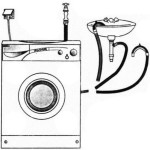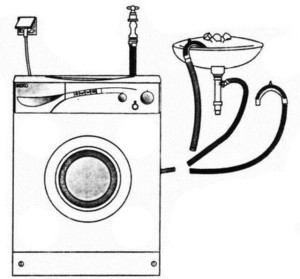
When purchasing a washing machine, buyers are immediately interested in the possibility of installing it and are ready to pay the master for this service. But they do not even think that it is possible to correctly connect the washing machine to the water supply system on their own, and it will not take much time and effort.
- Installing the washing machine: preparation for the process
- What do we need to connect the washing machine?
- How to install a washing machine?
- Draining the washing machine
- Connecting the washing machine to the water supply
- Hot water connection: how effective is it
- How to properly connect the washing machine to the mains?
- Installing a washing machine by level
- Installing the washing machine under the sink and countertop
Installing the washing machine: preparation for the process
Before buying a washing machine, you need to consider the options for its location. This can be the installation of a washing machine in the bathroom or in the kitchen, and there are variations of its installation. In the kitchen, the washing machine can be installed under the countertop, and it will fit perfectly as a piece of furniture. In the bathroom - under the sink, but you need to know all the nuances.
Important:
After delivery and unpacking of the washing machine, it is very important to remove the four transport bolts that hold the drum, otherwise this will lead to its breakdown, for more details see the instructions.
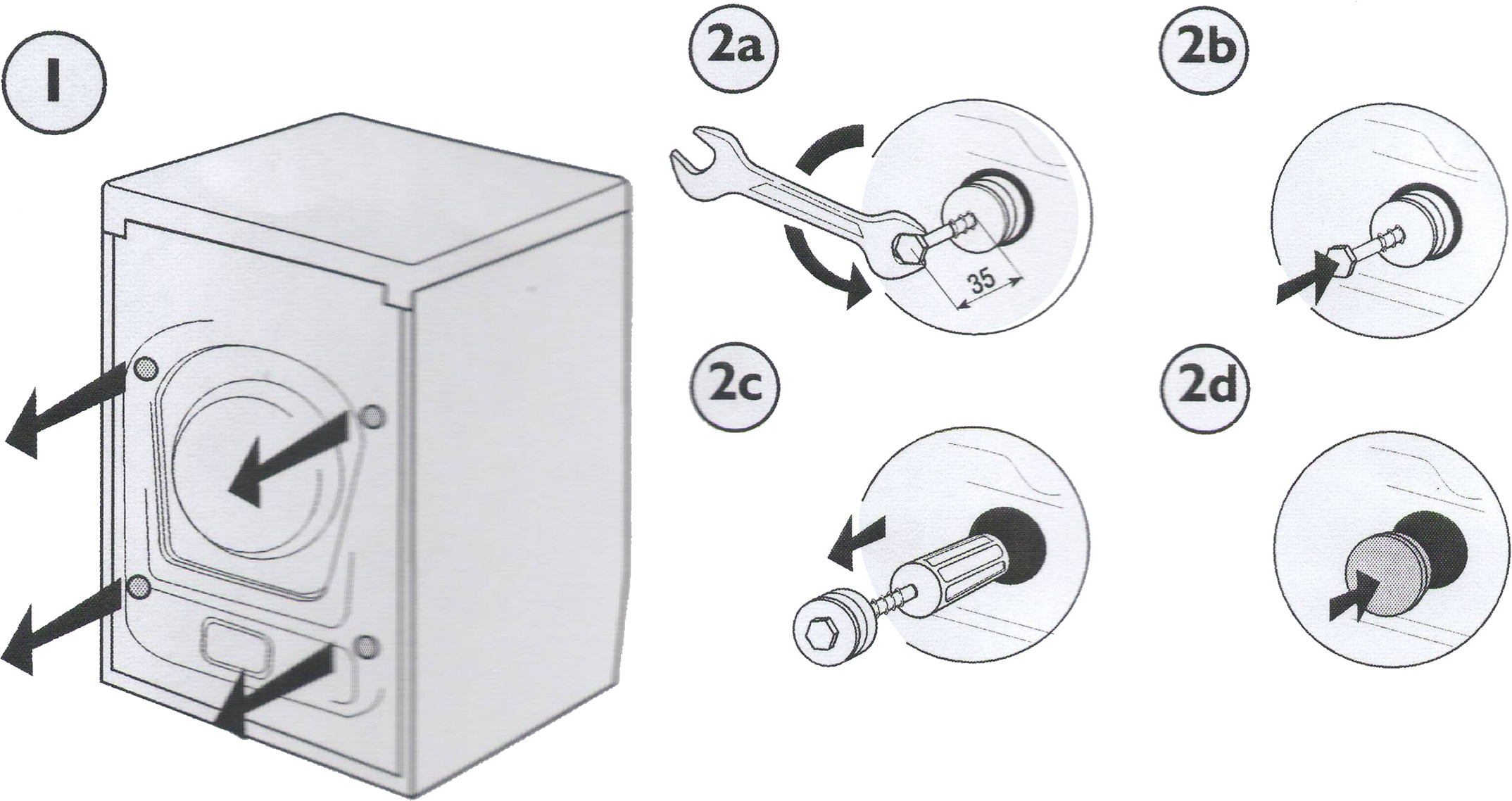
We unscrew the shipping bolts before installation. There can be 3 or 4 of them.
The machine is best placed on a concrete floor, on a flat surface. For slippery surfaces, it is recommended to place a rubber mat under the device.
In this video, you will learn how to connect a washing machine with your own hands to the sewer and water supply.
What do we need to connect the washing machine?
To connect the washing machine with our own hands to the sewerage and water supply, we need an adjustable wrench and a gas wrench. You also need to stock up on auxiliary parts:
- Ball valve - 1 piece
- threaded adapter - 4pcs
- cast iron tee - 1pc
- Tape for sealing threaded connections
- Sewer pipe with a diameter of 32mm - as required
- Sewer outlet Ø110x90
![]() See also - Do-it-yourself grounding of the washing machine
See also - Do-it-yourself grounding of the washing machine
How to install a washing machine?
The installation process is performed in the following sequence:
- Sewer connection.
- Connecting the washing machine to the water supply.
- Electrical connection.
- Leveling the machine
Draining the washing machine
There are three types of connecting the washing machine to the sewer:
- Draining water into the toilet or bathroom.
- Draining water into a siphon.
- Sewer connection
The easiest way is to drain the water into the bathroom or sink (if the installation of the washing machine is intended for the bathroom). This requires a hose through which all the dirty water will drain. It must be fastened so that the top is 60 cm higher than the washing machine; be sure to fix the hose with special fasteners or a rope, since under the pressure of water it can fall to the floor.
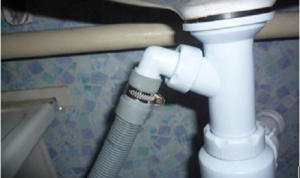
It looks like a siphon under the drain of a washing machine
In order not to bother with hoses, you can drain through a siphon. A siphon with a special outlet for washing machines can be purchased at any specialty store or market. The outlet must be above the siphon so that dirty water from the sewer does not enter the device. This method of draining is considered the most reliable, since water cannot spill onto the floor.
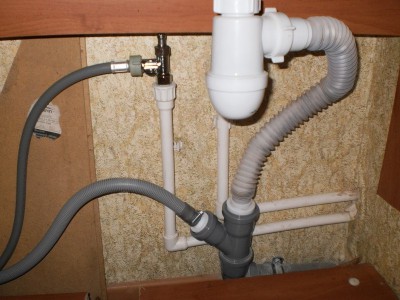
When connecting the washing machine to the sewer, you can buy an additional siphon. The drain hose is connected to the device on one side at a height of 80 cm, on the other hand it is introduced into the sewer pipe through a siphon. It is very important that the hose is in a straightened state, otherwise it will not drain.
Connecting the washing machine to the water supply
When supplying water to the device yourself, it is important to consider the pressure of the water in the pipes and the level of pollution. They install filters for water purification, they will increase the life of your equipment. The filter cuts into the water pipe using a tee.
To supply water to the washer, you can use ready-made taps to the drain tank or mixer, or connect through a tee.
There are the following options for connecting the washing machine to the water supply:

- Tie-in into the pipeline using a compression sleeve. This requires a ¾ ”hose. One part of the hose is supplied to the machine, and the second to the valve, which we independently cut into the water pipe using a coupling. The parts of the coupling are shown in the figure. It is attached to the pipe with bolts; a hole is made in the pipe for the flow of water. A tap is inserted into the threaded hole, which turns on and off after each wash.
- You can connect the washing machine to the water supply in an easier way using a tee. A flexible hose is connected to the mixer or to the water supply to the cistern. Using a tee, the hose is connected to the mixer. This connection option is temporary, since the mixer hose must be unscrewed during washing.
- If your house has metal-plastic pipes, then a tee fitting is used to connect to the water supply. Having cut out a piece of pipe in the right place, a tee is inserted, to which a ball valve is connected.
To prevent water from flowing through the tee, use seals. Tee, coupling, fitting, adapter, ball valve can be purchased in special stores.
You can connect the washing machine not only to cold but also hot water.
![]() See also - Which drum is better made of stainless steel or plastic?
See also - Which drum is better made of stainless steel or plastic?
Connecting to hot water: how effective is it
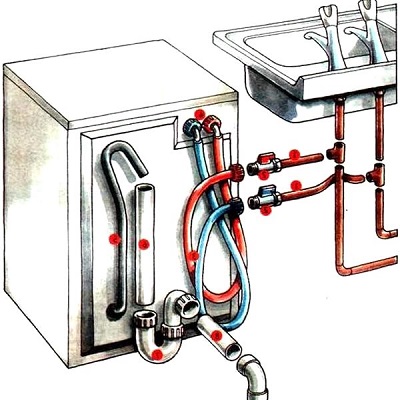
Sometimes, making their own connection to the water supply, many bring the machine to hot water. For this, a tee is also used for ordinary pipes, and a tee is a fitting for metal-plastic ones.
When connected to hot water, you can save energy, but at the same time, you need to consider the methods of supplying hot water:
- centralized delivery of hot water;
- heating by local water heaters.
With a centralized supply of hot water, its temperature is + 50 ... + 70 degrees. The device at the initial stage of washing can take such a temperature as an emergency and stop the entire process. Therefore, if utility organizations comply with all the norms for supplying hot water, then in this case only cold water supply is possible.
When heated by local heaters, connection to hot water is possible only if the temperature on the water heater is constantly changing.When soaking laundry, the water temperature should not exceed 40 degrees, at the time of washing, select the temperature based on the degree of contamination of the laundry, rinse at the lowest possible temperature.
Therefore, when connecting to hot water, weigh the pros and cons.
How to properly connect the washing machine to the mains?
Since we are talking about the constant contact of the device with water, it is best to call a specialist for these purposes. But if you are confident in your abilities, you can do it yourself.
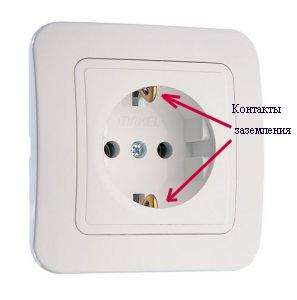
In this case, the following conditions must be taken into account:
- The washing machine installation should be near a 3-wire electrical outlet.
- A grounding bus must be installed in the shield, the wire must be reliably insulated.
- If necessary, use only a grounding extension cord.
- For a grounding electric cable, use a wire with a cross section of more than 3 mm.
As you can see, knowing all the steps and rules, installing a washing machine is a simple process.
Installing a washing machine by level
In order for a new washing machine to work for a long time and flawlessly, for this it is necessary to set it strictly at a level. First, install the washing machine in a prepared place, then we take a small level and achieve the ideal location of the washing machine in the horizon. There are support legs underneath the washing machine. Slowly twisting them, you can achieve the necessary horizontalness. In modern washing machines there is an automatic machine, such legs are available only in the front, the rear legs are not adjustable, therefore the entire leveling process occurs only due to the front legs.
It is not recommended to fit pieces of linoleum or blocks under the washing machine - this can lead to excessive vibration. A concrete floor is ideal for installing the washer. It is important to fix the adjusted support legs in the required position - for this, each support leg is equipped with a lock nut. If you do not fix the lock nut, then with each wash, the legs will unscrew, as a result of which the level of the washing machine will break, and you will need to reinstall the washing machine yourself.
Installing the washing machine under the sink and countertop
In a more modern design of the arrangement of rooms, the installation of a washing machine under the sink in the bathroom has become widespread. It not only looks beautiful, but also saves space.
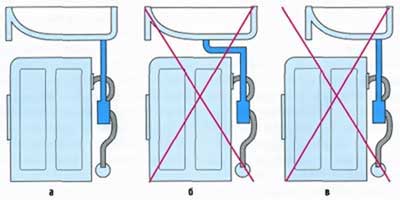
The figure shows a diagram of the correct installation under the sink.
For such a bath arrangement it is necessary:
- choose a special machine for a water lily sink with dimensions of 60 x 30 cm;
- pick up a sink measuring 60 x 60 cm;
- install the sink so that it protrudes slightly above the machine, so water will not spill onto the equipment;
- the drain pipe from the sink should pass behind the machine, and not above it.
To save money, you can buy a machine and a sink right away.
In the kitchen, the washing machine can be hidden under the countertop or put in a cupboard where it will not be visible at all. If there is very little space in the kitchen, then top-loading machines are installed, because its width is only 40 cm.
If there is enough free space, then machines with horizontal loading of linen are installed under the tabletop.
By following all the instructions and adhering to the tips, you will know how to connect the washing machine yourself without any problems.
See also:

